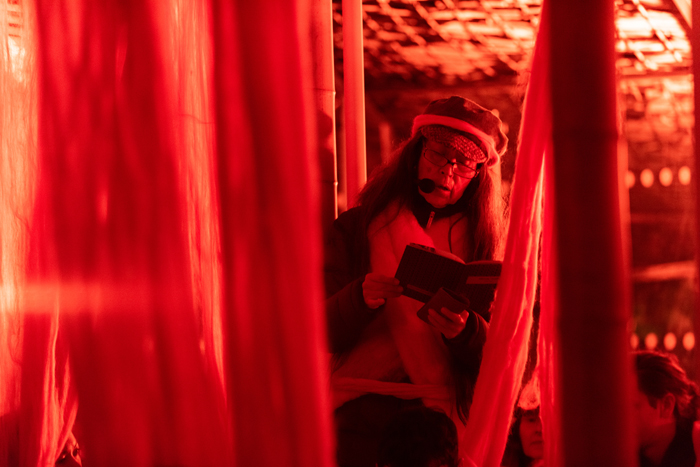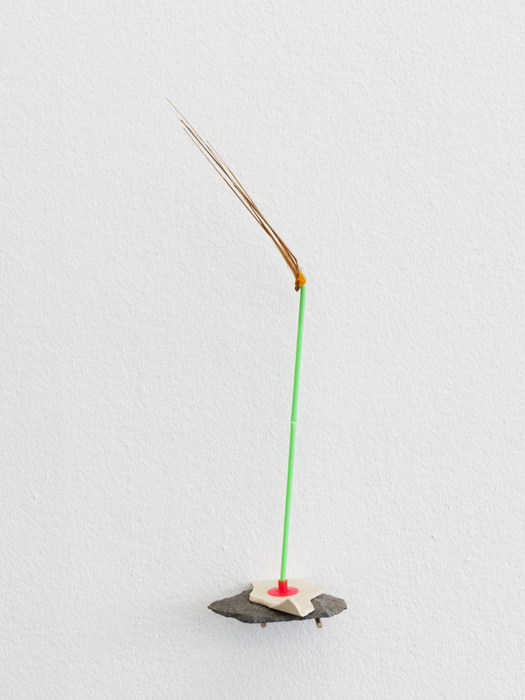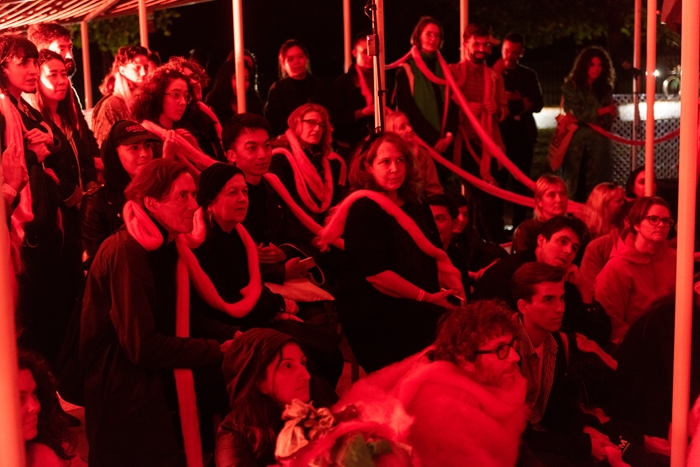We are sitting on mats beneath an undulating slate roof, a structure that forms this year’s Serpentine Pavilion commission, to watch Chilean artist, poet and activist Cecilia Vicuña’s performance Clit Nest (2019). Hisses and whispers echo from speakers, the source of which, it transpires, is the artist herself as she winds her way through the audience. Singing, muttering, reciting and making jokes as well as these more indeterminate articulations, she throws long, soft spools of neon-pink-dyed vicuña wool (her namesake and an animal sacred to indigenous Andean cultures) into the crowd before wrapping us in thick pink squares of the same wool so we become clits ourselves – a collective organism, a potential orgasm. The atmosphere is mysterious and at times humorous. We have come here tonight, she says, to change the world.
This bold claim is consistent with the preoccupations of a career that stretches back to the late 1960s, and begs a question that feels, in 2019, at once timely and exhausted: what kind of art might contribute to a global uprising for political and ecological justice? Vicuña’s answer seems to be that the utopian possibilities of collective action should be understood not only through practical political outcomes but also in terms of enhanced feeling and sensuality. With its cavelike setting, Clit Nest could be seen as a continuation of Abstract Hut, a cane-built enclosure filled with paintings alluding to political and environmental crises that was exhibited as part of the Arts Festival for Democracy held at the Royal College of Art in 1974: Vicuña said at the time that ‘socialism has to be warm and erotic’. Her vision is not unlike that espoused in Lynne Segal’s recent book Radical Happiness: Moments of Collective Joy (2017): an expansion of the possibilities of what liberation can be.

Now in her seventies, Vicuña was born in Santiago and has lived in exile – primarily in New York – since the death of President Salvador Allende during General Augusto Pinochet’s 1973 military coup (at the time of writing, renewed protests against inequality are sweeping the Chilean capital). A supporter of Allende’s Popular Unity government, she founded Tribu No as one of her first actions. This small group of young artists and writers – including Julio Cortázar – dedicated itself to resistance, liberation and ‘collective joy’ (her term, predating Segal’s use). As well as writing and picture-making, Tribu No performed cryptic rituals, played games and enacted (occasionally naked) happenings – all guided by Vicuña’s ‘No Manifesto’ – as a method of refusing the prevailing colonial and neoliberal global order. Having exhibited her surreal mural-style figurative paintings inspired by indigenous aesthetics – featuring, among others, recurring hallucinatory nudes of Janis Joplin and Joe Cocker against brightly coloured dreamlike forests – Vicuña moved to London in 1972 to study at the Slade School of Fine Art. She felt she could not (and never did) return to Chile, instead becoming a central force behind Artists for Democracy – a movement that assembled a large occupation in Trafalgar Square in protest against the coup – before moving to Bogotá. ‘What can art, and the art world, do in Chile and beyond?’ she wrote in a recent statement about the renewed protests. ‘Spread the awareness of the violence that distorts information, language, and images, the “tools” of our trade. The art world can stand for transparency to empower our ability to discern purpose and intent. Otherwise the mad destruction of the land and people’s rights, along with the right to question what is true as it is happening in Chile, will continue to spread like wildfire to all nations.’
One of the most important works from her earlier period, the banner Chile Salutes Vietnam! (1975), against a backdrop of red flowers and green ferns, depicts a Mapuche Indian woman and a Vietnamese guerrilla woman exchanging a rifle and a red book emblazoned with a reference to Ho Chi Minh’s August Revolution. Despite the strength or boldness of its symbolic expression, the image is strangely delicate and spectral. Her political leanings were equally apparent in a series of paintings titled Homage to Vietnam, exhibited at the Fundación Gilberto Alzate Avendaño in Bogotá in 1977. Exile also prompted Vicuña to explore different media and activities, producing films and getting involved in theatrical design, working with indigenous communities and, most fruitfully, developing performance poetry (while committed to the free circulation of oral poetry compared to its written equivalent – she calls it “the other poetry” – she has published a dozen books and edited a volume of Mapuche poetry). She also started to produce the installations that she dubs “spatial poetics”, incorporating weaving, banners and sculpture, mostly notably in the form of quipus, great drapes of vibrantly coloured knotted wool hung from the ceiling.

Yet it is only in recent years that her work has been more widely recognised and exhibited institutionally, with a retrospective at Witte de With in Rotterdam just closing and the final stop of a travelling US survey show opening at the Museum of Contemporary Art, North Miami. One reason for this is due to increased curatorial attention to feminist and indigenous projects – mending holes in art history, as with the restoration of Leonora Carrington, whose surrealist paintings inspired the young Vicuña. Another, as the Dutch exhibition’s informative catalogue points out, is the problematisation of genre or canon itself: Vicuña’s work sits adjacent to, but nonetheless defies categorisation as, Surrealism, Conceptual art, participatory art, arte povera and avant-gardism in the Western sense.
Paintings from the early 1970s such as Sueño, Janis Joe (Janis Joplin and Joe Cocker) and the Heroes of the Revolution portrait series (these last, reassembled in 2017 for Documenta 14, feature collage-esque and indigenised portraits of Marx, Allende, Castro and Lenin) are inspired by the seventeenth-century mestizo paintings that appropriated colonial Spanish iconography in the flat style of ex-voto paintings to portray indigenous deities, or Pachamamas. Vicuña tells me that these “clumsy” or “bad” paintings were celebrated at the time because they offered a “narrative decolonisation of art images” (by which she means a move away from European art history) that emerged in tandem with social movements all over the world. “After the military coup the same paintings became forgotten. The same paintings…” she says, with no little wonderment. She sees the recent interest in her work as a sort of cyclical return. “Now there is another uprising, different in orientation – climate justice and protecting the survival of humanity. This engagement is what gives the paintings meanings. But is this, maybe, an illusion?” I ask her what might be illusory. “The wishful thinking on our part that uprising can really have the effect that we need, and that it can come through us.”
She considers Extinction Rebellion to be a game-changer, if “people really join in, not just intellectuals but the whole of society”. This sort of radical openness to communicative possibility – with the nonhuman as much as the human – that retains nuance (and a Marxist genealogy) is characteristic of Vicuña’s work. ‘Wishful thinking’ brings to mind her precarios, spatial metaphors or multidimensional poems that are assemblages of found objects that she first produced in 1966 and continues to make now, such as the spindly Árbol de vida (Tree of Life, 1983) in which tiny threads secure seashells, bundles of wool and other fragments to branches drooping towards and then rising high above the ground, or Cementerio (Cemetery, 1982), in which two wooden fragments reminiscent of a stalagmite and a stalactite are placed upright on a wooden plinth alongside a small bone. Long before XR, Vicuña was preoccupied with ecological precarity in creating works that would be washed away by the sea: rather than Land art’s forced marks, such assemblages – like suggestions, thoughts and wishes – disintegrated and disappeared. Composed of basuritas (little garbage), they likewise offered no clear delineation between ‘nature’ and ‘culture’, while addressing the idea of disposability enshrined by the environmentally ruinous logic of late capitalism.
I ask her if she ever gets tired of reaching out to people through collective action, performance and collaboration, and wants instead to withdraw. Her response indicates that she considers herself not an ex nihilo creator but a channeller – vicuña wool after all is symbolically associated with a thread of running water, the stream of life. “The work has an agency. I am in the service of what the work wants and needs. I am the listener. I am attending to the process. I want to reach people. The work is a musical sound that is repelling or attracting to people. The process is completely autonomous […] People are hungry for something that comes from a place of questioning – a feeling, not manipulation or control.”

In contrast to recent ecophilosophy that focuses on material objects as having a form of agency, the work here is a springboard to encounter not another material object but a ‘sensual possibility’. Hence the importance of participating in a performance – be it the Tribu No happenings or the Clit Nest – that must be manifested in an ephemeral and unstructured way. Flexibly referential language is multilingual and mestizo, sounds we may recognise but only know emotively. This concept reminds me of composer La Monte Young’s manifesto ‘Dream Music’, published in the 1971 ‘Psychedelic Issue’ of Aspen magazine, in which he describes an indigenous and continuous sound taken up by different musicians and students to become a real living organism, ‘one with a capacity to propel itself by its own momentum’.
If this is one metaphysical aspect of Vicuña’s spatial poetics, then her weaving, like the bright pink quipu (‘knot’ in Quechua) hanging down in labialike folds in the centre of the Serpentine Pavilion, and a motif of her practice dating back to the 1960s, is another. Vicuña’s quipus are completed by participants in rituals involving these objects, and by the visitors to exhibitions who must negotiate them. They are, if you like, created by weaving constructs as intangible and virtual as they are material. Always constructed of threaded and knotted cords, quipus allude to a Quechua cosmology that connects all beings through imaginary lines to the summit of a mountain (the origin of water), as well as an Incan method for administration (like early Babylonian clay tablets): a form of record-keeping turned into narrative device for cultural memory. Yet Inca civilisation is also confusingly, given the artist’s correlation of indigeneity with colonial resistance, another language of empire. In this sense Vicuña’s quipus as an appropriation are, as the critic Lucy Lippard has noted, more indigenous-looking than specifically indigenous. A hazy memory that takes a general nonnative ignorance as to what is indigenous as a ground for possibility: in this indeterminate space we are all immigrants, as Vicuña writes in a 2016 essay, ‘Language Is Migrant’.
Though her associations between quipu and the gendered female body also appear in works such as Quipu Womb (2017), in which menstrual-red woollen threads flow downwards from a suspended circle (also shown at Documenta 14), I ask Vicuña why she chose the clitoris as the focus of Clit Nest. The clit, she says down the phoneline – another quipu? – is “the organ that humanity has that exists exclusively for joy […] the clit is that by which the body is guided, an invitation towards plenitude and joy”. From a scientific viewpoint this isn’t factually correct (the clitoris does play a role in assisting reproduction), so does it risk seeming reductive and biologically essentialising? Julia Bryan-Wilson has written that ‘Vicuña to me is not an essentialising artist; she does not make claims about a specifically female gendered body that is discrete or that she polices in any way. But it is still unusual, in 2017, to go to an international exhibition like Documenta and see a piece that is about menstruation front and centre.’ I recall the mystical iconography of an early painting, Leoparda de Ojitos (1976), in which that Andean mountain cat, covered with eyes, exposes its vagina. Vicuña wrote of the painting that ‘one could think that it is the “eyes of instinct” that open when we allow ourselves to be carried away by a form of knowledge that is richer and deeper than rationality’. Maybe to appreciate the work the viewer has to share Vicuña’s faith in the possibility of channelling collective joy as an event that begins in, and is inseparable from, the interconnected body. And in terms of being beyond rationality, her practice is also – to return to environments – one that relies on indeterminacy, a quality of entangled environments too. I might not have felt that I was changing the world during the performance of Clit Nest, but I was, it turns out, being attuned to something – an optimism?
Cecilia Vicuña: About to Happen is at the Museum of Contemporary Art, North Miami, through 29 March 2020
From the December 2019 issue of ArtReview
